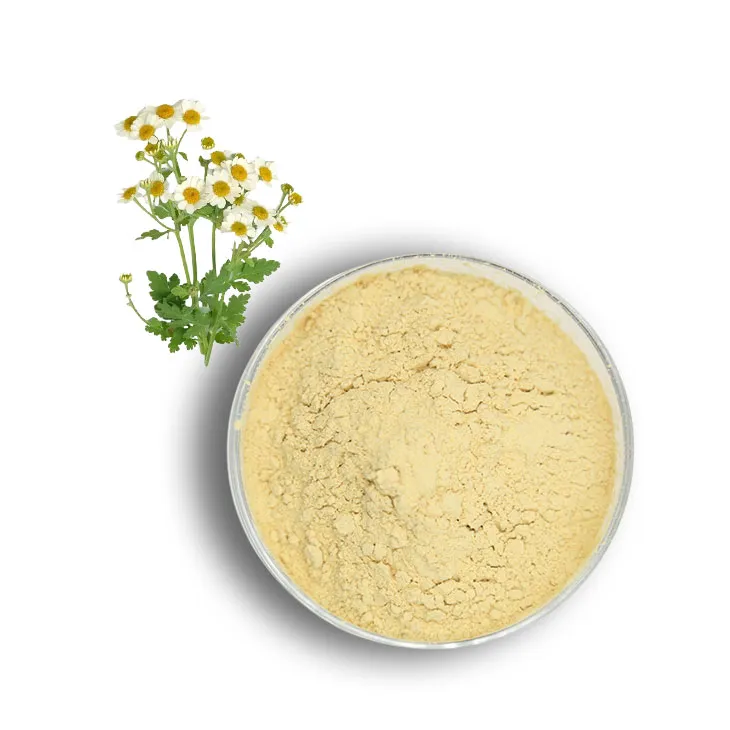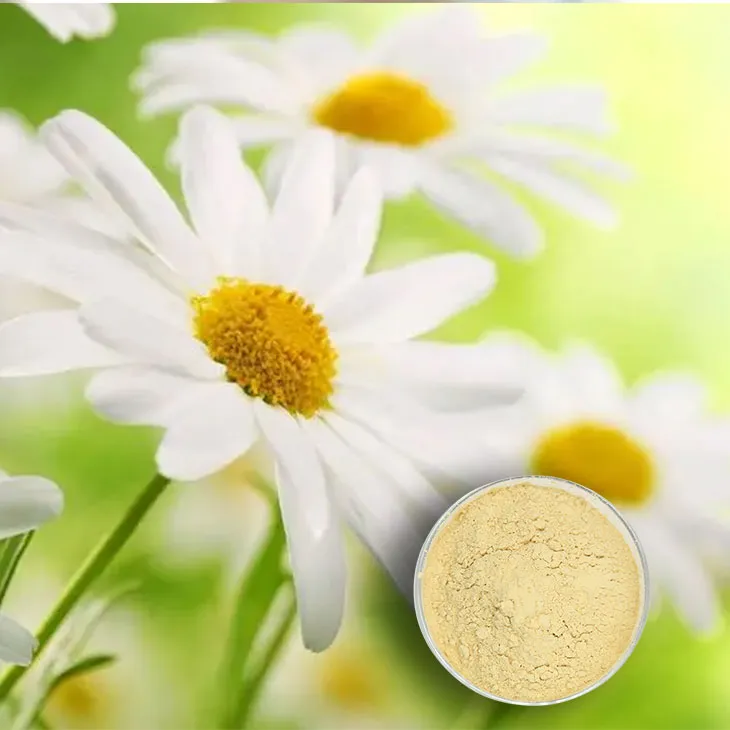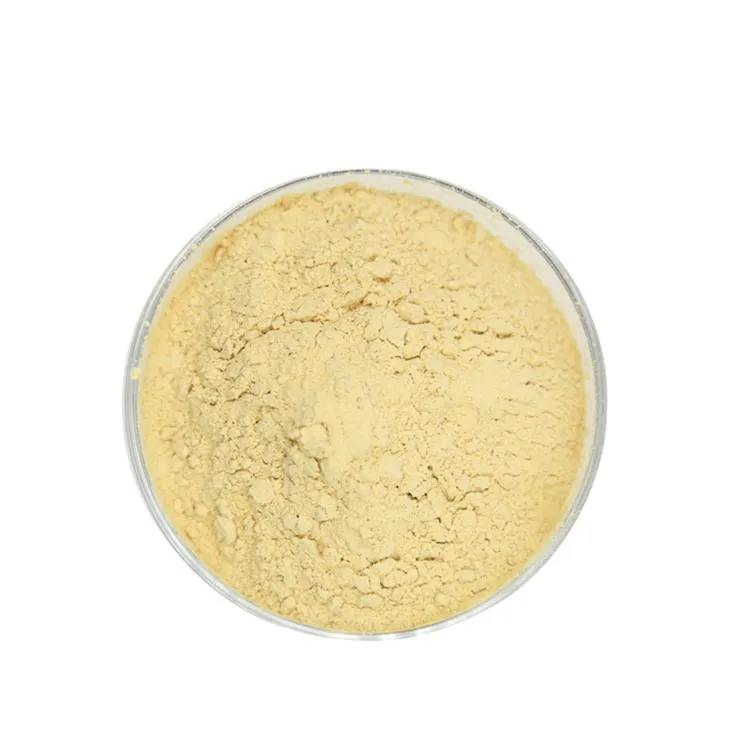- 0086-571-85302990
- sales@greenskybio.com
Benefits of Feverfew Extract in Cattle Feed.
2024-11-13

1. Introduction
Cattle farming is a significant part of the agricultural industry, and the quality of cattle feed plays a crucial role in the overall health and productivity of the animals. In recent years, there has been an increasing interest in exploring natural additives to enhance the quality of cattle feed. One such promising additive is Feverfew Extract. Feverfew, also known as white chamomile, has been studied for its potential benefits when added to cattle feed.

2. Anti - Inflammatory Properties
2.1 Inflammation in Cattle Inflammation can be a major concern in cattle. Cattle may experience inflammation due to various reasons such as joint problems, which can be caused by factors like excessive weight, improper movement, or genetic predisposition. Additionally, stress - related issues can also lead to inflammation in the animals. Stress can occur during transportation, changes in the environment, or overcrowding. When cattle are in a state of inflammation, it can cause discomfort and reduced mobility, which in turn can affect their growth, reproduction, and overall well - being.
2.2 Role of Feverfew Extract The addition of Feverfew Extract to cattle feed offers a natural solution to combat inflammation. Feverfew contains bioactive compounds that have anti - inflammatory properties. These compounds work by inhibiting the production of inflammatory mediators in the body of the cattle. When the levels of these inflammatory mediators are reduced, the inflammation in the joints or other affected areas is alleviated. As a result, the cattle experience improved comfort and increased mobility. This is especially important for the proper movement of the animals, allowing them to graze, move around in the pen, and access water and feed without difficulty.

3. Impact on Rumen Microbiota
3.1 Importance of Rumen Microbiota The rumen is a vital part of the digestive system in cattle. It is home to a complex community of microorganisms, known as the rumen microbiota. A healthy rumen microbiota is essential for the proper digestion of fibrous feeds. Cattle are ruminants, which means they mainly consume plant - based materials that are rich in fiber. The rumen microbiota breaks down these fibrous feeds through a process of fermentation. This fermentation process not only helps in the digestion of the feed but also releases nutrients that are essential for the growth and development of the cattle.
3.2 Promotion of Beneficial Bacteria Feverfew extract has been found to have a positive impact on the rumen microbiota. It promotes the growth of beneficial bacteria in the rumen. These beneficial bacteria play important roles in the fermentation process. For example, they help in the breakdown of complex carbohydrates present in the feed into simpler sugars, which can be easily absorbed by the cattle. By promoting the growth of these beneficial bacteria, feverfew extract improves the overall efficiency of the fermentation process in the rumen. This leads to better digestion of the feed, resulting in increased nutrient availability for the cattle.

4. Improvement in Meat and Milk Quality
4.1 Physiological Enhancement By adding feverfew extract to cattle feed, the physiological functions of the cattle are enhanced. The anti - inflammatory properties and the positive impact on the rumen microbiota contribute to the overall health of the animals. When the cattle are in a better state of health, their physiological processes function more optimally. For example, their metabolism is more efficient, which can affect the composition of the meat and milk they produce.
4.2 Nutritional Value of End Products The improvement in the physiological functions of the cattle can lead to better - quality meat and milk. In the case of meat, it may have a more favorable fat content, better texture, and improved flavor. For milk, it can have a higher nutritional value, with increased levels of important nutrients such as proteins, vitamins, and minerals. Consumers are increasingly interested in high - quality meat and milk products, and the addition of feverfew extract to cattle feed can be a way to meet this demand.

5. Safety and Dosage Considerations
5.1 Safety of Feverfew Extract While feverfew extract shows great potential in cattle feed, it is important to ensure its safety. Feverfew is a natural plant extract, but like any additive, it should be carefully evaluated. Preliminary studies have not shown any significant adverse effects when used in appropriate dosages. However, further research is needed to fully understand any long - term effects on the health of the cattle. It is also important to ensure that the feverfew extract used is of high quality and free from contaminants.
5.2 Dosage Determination Determining the appropriate dosage of feverfew extract in cattle feed is crucial. The dosage may depend on various factors such as the age, weight, and health status of the cattle. Younger cattle may require a different dosage compared to adult cattle. Additionally, the type of feed and the overall management system of the cattle farm may also influence the optimal dosage. Research is ongoing to establish the most effective dosage levels for different scenarios in cattle farming.

6. Future Research Directions
6.1 Long - Term Effects Although the short - term benefits of feverfew extract in cattle feed are promising, more research is needed to understand the long - term effects. Long - term studies can help determine if there are any cumulative effects on the health of the cattle, as well as on the quality of meat and milk over extended periods of use. This will be important for the sustainable use of feverfew extract in the cattle industry.
6.2 Interaction with Other Feed Additives Cattle feed often contains multiple additives, and it is essential to study how feverfew extract interacts with other additives. There may be synergistic or antagonistic effects when combined with other substances such as antibiotics, vitamins, or other herbal extracts. Understanding these interactions can help in formulating more effective and safe cattle feed mixtures.
6.3 Optimization of Extraction Methods The extraction method used to obtain feverfew extract can affect its quality and effectiveness. Future research could focus on optimizing the extraction methods to ensure that the extract contains the maximum amount of beneficial compounds. Different extraction techniques, such as solvent extraction, supercritical fluid extraction, or microwave - assisted extraction, could be compared to find the most suitable method for obtaining high - quality feverfew extract for cattle feed.
7. Conclusion
In conclusion, the addition of feverfew extract to cattle feed offers several benefits. Its anti - inflammatory properties can improve the comfort and mobility of cattle, especially in cases of joint problems or stress - related inflammation. The positive impact on the rumen microbiota promotes better digestion and nutrient availability. Moreover, it shows promise in enhancing the quality of meat and milk. However, safety and dosage considerations need to be carefully addressed. Future research in areas such as long - term effects, interaction with other feed additives, and optimization of extraction methods will further enhance our understanding and utilization of feverfew extract in cattle feed. Overall, feverfew extract has the potential to be a valuable addition to the field of cattle farming, contributing to the production of healthier animals and higher - quality end products.
FAQ:
What are the anti - inflammatory benefits of white chamomile extract in cattle feed?
White chamomile extract has anti - inflammatory properties. Inflammation can occur in cattle due to joint problems or stress - related issues. By adding the extract to cattle feed, it helps in reducing inflammation, which improves the comfort and mobility of the animals.
How does white chamomile extract affect the rumen microbiota?
White chamomile extract has a positive impact on the rumen microbiota. A healthy rumen microbiota is essential for the proper digestion of fibrous feeds. The extract promotes the growth of beneficial bacteria in the rumen, which in turn improves the fermentation process and nutrient availability.
Can white chamomile extract improve the quality of meat and milk?
Yes, it shows promise in improving the quality of meat and milk. By enhancing the physiological functions of cattle, it can lead to better - quality end products with enhanced nutritional value.
What are the overall benefits of adding white chamomile extract to cattle feed?
The addition of white chamomile extract to cattle feed offers multiple benefits. It has anti - inflammatory properties, positively impacts the rumen microbiota, and improves the quality of meat and milk.
How much white chamomile extract should be added to cattle feed?
The appropriate amount of white chamomile extract to be added to cattle feed may vary depending on factors such as the age, weight, and health status of the cattle. It is best to consult a veterinarian or an animal nutritionist to determine the optimal dosage.
Related literature
- The Role of Herbal Extracts in Animal Nutrition"
- "Beneficial Effects of Botanical Additives in Cattle Feed"
- "Anti - Inflammatory Agents in Livestock Feed: A Review"
- ▶ Hesperidin
- ▶ citrus bioflavonoids
- ▶ plant extract
- ▶ lycopene
- ▶ Diosmin
- ▶ Grape seed extract
- ▶ Sea buckthorn Juice Powder
- ▶ Beetroot powder
- ▶ Hops Extract
- ▶ Artichoke Extract
- ▶ Reishi mushroom extract
- ▶ Astaxanthin
- ▶ Green Tea Extract
- ▶ Curcumin Extract
- ▶ Horse Chestnut Extract
- ▶ Other Problems
- ▶ Boswellia Serrata Extract
- ▶ Resveratrol Extract
- ▶ Marigold Extract
- ▶ Grape Leaf Extract
- ▶ blog3
- ▶ blog4
- ▶ blog5
-
Organic Tongkat Ali extract powder factory.
2024-11-13
-
How to make powder with ashwagandha extract.
2024-11-13
-
Rosehip extract manufacturers from China.
2024-11-13
-
The best cat's claw extract in nature.
2024-11-13
-
Chinese Dandelion Leaf Extract Suppliers.
2024-11-13
-
Phyllanthus Emblica Extract
2024-11-13
-
Hericium erinaceus extract powder
2024-11-13
-
Okra Extract
2024-11-13
-
Mulberry leaf Extract
2024-11-13
-
Peppermint Extract Powder
2024-11-13
-
Agaricus Blazei Extract
2024-11-13
-
Green coffee bean Extract
2024-11-13
-
Tongkat Ali Extract Powder
2024-11-13
-
Soy Extract
2024-11-13
-
Epimedium extract powder
2024-11-13





















